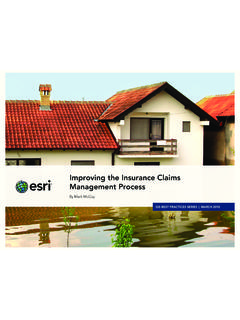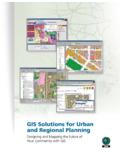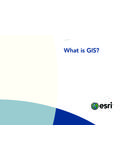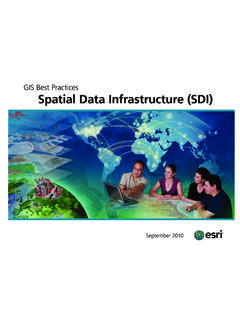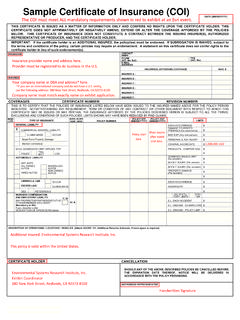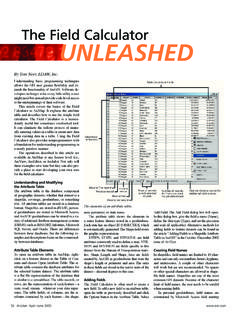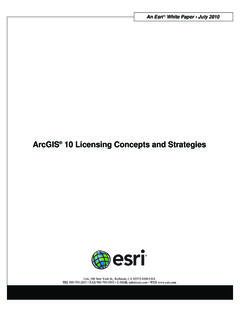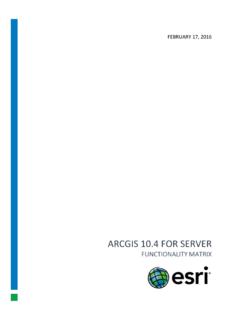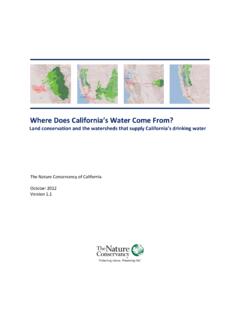Transcription of GIS Solutions for Surveying - Esri
1 GIS Solutions for SurveyingBuilding New OpportunitiesGIS Solutions for SurveyingBuilding New OpportunitiesSurveyors depend on a variety of software and technology to gather existing information, collect new information, analyze data, produce plans, manage projects, and deliver accurate data. Geographic information system (GIS) technology brings this functionality and more to one place, providing a central location to conduct spatial analysis, overlay data, and integrate other Solutions and systems. GIS is built on a database rather than indi vidual project files, enabling surveyors to easily manage, reuse, share, and analyze data, saving them play a central role in a range of government agen cies and private organizations, from planning and construction to engineering and land boundary determination. ESRI GIS software Solutions are interoperable with the many data formats used in the field and office, allowing surveyors to provide data to various agencies in the required format while maintaining the data s core integrity.
2 The ArcGIS suite of software helps surveyors manage critical data by bringing their technologies together including everything from automated data collection with traditional instruments to the most modern InfrastructureSurveying is a vital part of infrastructure development, from building roads and communication systems to establishing transportation networks and pipelines. A centralized information system based on ESRI GIS software provides the framework for maintaining and deploying critical data and applications across every aspect of the infrastructure project including data collec tion, planning, construction, and operations management. With ESRI GIS, you can Securely store and manage vast amounts of spatial infor mation. Propagate data changes among multiple data sources. Ensure data integrity, consistency, and credibility. Integrate real-time tracking of features and events.
3 Tie GIS data to non-GIS applications. Allow those without GIS knowledge to take advantage of geographic Collection Specific functions to collect precise site data used for predesign analysis, design, and calculations including field survey, topography, soils, subsurface geology, traffic, lidar, photogrammetry, and other site-specific design-grade data. Predesign Analysis Analysis to support design including hydrology analysis, volume calculations, soil load analysis, traffic capacity, environmental impact, slope stability, materials consumption, runoff, erosion control , and air of new infrastructure data for new civil works including grading, contouring, specifications, cross sections, design calculations, mass haul plans, environmental mitigation plans, and equipment The mechanics and management for building new infrastructure including takeoffs; machine control ; earth movement; intermediate construction, volume and material, and payment calculations; materials tracking; logistics; and traffic Collection As-Built Surveying Specific functions to collect precise site data used for payment and documenting existing conditions.
4 Data collected in GIS formats can be seamlessly integrated into the operational GIS infrastructure without Including applications such as AM/FM; work order, outage, and asset management; vehicle routing; dispatch; maintenance; inventory tracking; SCADA; and planning functions for site location including environmental impact mitigation, economic analysis, regulatory permitting, alternative siting analysis, distance to utilities, and benefit/cost alternatives analysis. InfrastructureLife CycleThis architecture provides the tools to assemble intelligent GIS applications and improve a project process by giving engineers, construction contractors, surveyors, and analysts a single data source from which to work. Centrally hosting applications and data makes it easy to manage, organize, and integrate geo graphic data, including CAD data, from existing databases to visualize, analyze, and make decisions.
5 The system helps combat data communication errors, eliminating the need for multiple, flat files in disparate use GIS to manage the entire planning aspect of a Surveying project. GIS provides the tools necessary to research, develop, implement, and monitor the progress of a project and manage site location, environmental impact mitiga tion, eco nomic analysis, and other critical facets. Scenario based analysis can then be conducted, giving communities, govern ment agen cies, engineers, and others involved a thorough understanding of the project s impact. The planning aspect of a survey project has a number of unique requirements depending on its area, purpose, and overall goal. ESRI GIS technology helps fulfill these demands by facilitating traditional tasks more efficiently and easily accomplishing new tasks that were previously impractical or PlanningEquipped with GIS tools, surveyors quickly determine environ mentally sensitive areas; canopy; local control ; road networks; previous established boundaries; and zoning, permit status, and other critical information.
6 These enhanced capabili ties eliminate redundant efforts and promote coordination with other planning and government agencies. The information is stored and easily accessed for reuse with any project related to the location. GIS Benefits for Survey Planning Increase efficiency. Plan effectively for site location. Access vast amounts of publicly available geospatial data. Provide decision support. Automate tasks. Save money. View historic data. Integrate survey projects in a single supports many methodologies to create and manage coordinate geometry. Here, ArcEditor is used to enter COGO values from a survey plat for accurate data in an enterprise GIS. ArcGIS is used in the field on a Tablet PC support-ing redlining capabilities, which provides time-sensi-tive updates rapidly. ArcGIS Mobile technology supports many field workflows. Project Planning ArcGIS enables surveyors to locate and analyze survey s GIS software adds intelligence to spatial data, whether the data is generated in the field with GPS or remotely with lidar and photogrammetry.
7 Surveyors enter raw data, measurements, and field sketches directly into the GIS, enabling them to efficiently manage their data in a central repository (personal geodatabase) with other spatial information, streamlining workflows and improving productivity. Surveyors use GIS software and technology for collecting, importing, converting, and storing spatial measurement and computational fabrics for agencies and private businesses of any size. They integrate computations (COGO, traverse least squares, etc.) and preexisting networks as well as import spatial data feature classes and Measurement Surveyors rely on a range of data collection devices in the field, from total station angle measurements to high resolution 3D lidar point clouds. With ESRI s ArcGIS software, surveyors not only bring data straight from the field into a geodatabase in a seamless workflow, but they also take GIS data back into the field via a Windows CE device, data collector, or laptop com puter.
8 The software is customized to best meet the company s or surveyor s needs by optimizing functionality needed to complete a job or by developing custom field Solutions . Using ArcGIS for data collection enables surveyors to View, edit, and analyze survey data. Store data in a centralized environment. Use project-collected data to build an information system. Collect and transfer/transmit feature data directly from the field into the geodatabase. Improve efficiency by completing more workflow steps inside the GIS. Compute LSA, GPS differential corrections, and COGO corrections. Create and store important detailed description codes in the geodatabase. Customize workflows and/or data collection processes to suit individual needs and professional-grade GPS data in the field provides the starting point to an accu-rate enterprise GIS. Double-precision databases allow GIS to handle precise survey measurement data.
9 Data CollectionYou can easily manage parcel data in ArcGIS Survey Analyst Cadastral Editor. Case StudyThe City of Odessa, Texas, uses the Cadastral Editor to build new parcels into its cadastral fabric. It uses the flexible construction environment to enter the record lines from recorded subdivi sion plans, either by directly typing the information or clicking between previously created construction points. The construc tion spreadsheet grid provides immediate feedback and allows the city's land records managers to correct, if necessary, the COGO attribute values to match the legal record represented by the plan. Once satisfied with the construction lines, the editor clicks the Build button to create the parcels from the construc tion lines. These parcels can then be stored in the city s geo database in a local coordinate system or joined into the rest of the cadastral fabric and stored in the Texas State Plane Central NAD83 projected coordinate investigation is critical to planning new projects.
10 Surface and subsurface conditions influence survey methods, which affect proj ect cost and scheduling. Surveyors rely on the ArcGIS geodatabase to store, input, and query descriptive soil and geotechnical data and relate it to other predesign engineering information. Using search by elimination concepts, ArcGIS helps develop a heuristic approach to model the process of decision making and generate the potential sites for temporary facilities. The software s tools help solve construction layout problems and open a new way of think ing for managing spatial information. ArcGIS takes data that origi nates from many different sources and file formats and integrates it into a single application platform to support unique civil engineer ing workflows. Data can be created easily, intuitively, and correctly the first time in both 2D and 3D engineers use GIS to keep track of multiple urban and regional indicators, forecast future community needs, and plan accordingly to guarantee quality of life for everyone in livable communities.

